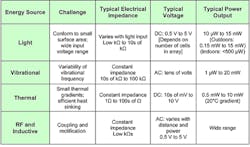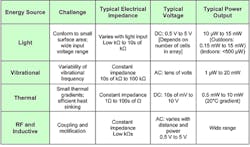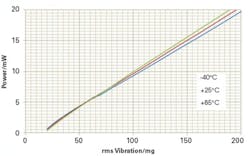Although solar arrays and wind farms are two of the larger sources of alternative energy, they’re not the only ones. Installations like these that exploit renewable energy resources sometimes are described as energy harvesting, but the term also includes smaller-scale approaches.
According to a recent report, “In 2009, more than 55% of the energy consumed in the United States was lost as low-temperature waste heat.”1 This heat can result from inefficiencies in industrial processes and electric motors or may truly be waste as in a car’s hot exhaust gases. Regardless of where it comes from, there’s a lot of it.
Sources
Efforts to reclaim some of this energy have been given a boost in a couple of ways. First, research continues to develop more efficient transducers. Depending on the reference cited, four or five categories comprise the sources of waste energy: vibration, thermal, solar, and RF emissions. Sometimes biological sources are included, but these often are just another form of thermal or vibrational energy. Typical characteristics are shown in Table 1.2
Table 1. Free Energy Sources
Source: Cymbet
Of these, RF emissions typically provide the least amount of power, and solar is best suited to outdoor applications. Most waste energy harvested indoors is generated by vibrational and thermal transducers.
Applications
The other significant contribution to energy harvesting has resulted from continuing reduction in the power demanded by low-level circuitry. Very low-level energy harvesting challenges the efficiency of power management circuitry and the sensitivity of the transducers themselves. If a large number of power sources are needed—as in mesh networks—then cost also is an issue.
Because so little energy may be available and often only intermittently, it must be stored until a sufficient amount is accumulated. A common feature of low-level energy-harvesting applications is very low duty-cycle operation: The circuitry mostly remains in sleep mode, awakening only infrequently and for a short time to perform the necessary operations—for example, measurement and transmission—followed by another long sleep period.
A great deal of interest has been generated by low-level solutions for a number of reasons. In remote locations, data acquisition and telemetry for extended periods may not be practical. Batteries only store so much energy, and to replace one could cost more than the project is worth. If the required power is small enough and if a reliable energy source is available, energy harvesting could be the solution.
Zigbee radio networks within buildings have become popular because they eliminate the cost of some AC wiring and its installation labor. The Zigbee PRO Green Power extension supports light switches that transmit a command using only the energy developed by flipping the switch—it’s recovered by a piezoelectric element.3
On a much larger scale, several companies are applying thermoelectric generator (TEG)-based devices to capture waste automotive engine and exhaust heat. The challenge comes from the high temperatures and frequent large temperature changes associated with this application. Volkswagen announced in 2008 that up to 600 W was available at highway speeds from an experimental TEG device. This represented about 30% of the load a conventional alternator would supply under the same conditions and improved fuel economy by about 5%.4
The combination of transducer and circuit developments and the high cost of conventional solutions have created many more opportunities for energy harvesting.
Transducers
Vibration
Tiny piezoelectric beams can be tuned to vibrate at the same frequency as a small source of vibrational energy. This type of resonant energy conversion boosts transducer output. Large vibrations can drive inductive generators based on relative motion between permanent magnets and coils of wire such as those made by Perpetuum.
A major challenge to vibrational transducers is that some sources of energy are random or at least vary in frequency by a significant amount. This means that resonant operation may be impractical, greatly reducing the power output. According to the Perpetuum website, operation at resonance is particularly important for low-level vibration.
With 50-mg vibration at the center frequency, the Perpetuum transducer develops about 4 mW. The company’s range of narrowband transducers is intended for industrial use with synchronous motors, and models are available with center frequencies of 50, 60, 100, and 120 Hz. Figure 1 shows the linear relationship between vibration level and output power as well as the small temperature dependence.
Figure 1. Minimum Power at Nominal Frequency and Voltage
Courtesy of Perpetuum
The company also addresses high-level rail energy harvesting. Because of the transducer design, the bandwidth broadens considerably at high vibration levels. This means that a train’s large and much less predictable vibrations still are efficiently converted to usable amounts of power.
Rather than a tuned resonator, Advanced Cerametrics (ACI) has developed a method of manufacturing very flexible ceramic fibers—the patented Viscose Suspension Spinning Process. As the company’s website explained, “[The] fiber is laminated into formable structures and cut to form, fit, and function via proprietary processes. These [products] are called piezoelectric fiber composites (PFCs)…. These PFCs are actually small generators of electricity that are powered by motion…. Harvested mechanical energy (vibration, compression, or flexure) can be tapped to deliver extremely long life-span power in places where this was previously impossible.”
Michael Hendricks, the company’s vice president and COO, explained, “The flexibility of ACI’s patented fiber and fiber composites gives ACI’s products a physically superior capability to convert useful amounts of electrical power from vibration or motion via the piezoelectric effect.” He concluded, “ACI uses the same or similar components to reverse this process and actively dampen vibration.”
More conventional lead zirconate titanate (PLZT) plates, actuators, and sensors as well as energy harvesters are available from Piezo Systems. Two types of material are used: type 5A having a 350°C Curie temperature but lower sensitivity and type 5H with a 230°C Curie temperature but higher sensitivity. The company’s energy harvesters all are of the bending-beam type. A kit is available with a mounted and terminated beam as well as energy-harvesting circuitry. Alternatively, the beams are available on their own.
Thermal
TEGs use the Seebeck effect to directly develop an output voltage when a sufficiently large temperature difference exists across their elements. This is the same effect that makes a thermocouple work, but TEGs generally have many alternating P-N pairs that act in series to develop a larger voltage. Also, they use materials that convert the temperature difference to electricity more efficiently than occurs in a metal-to-metal thermocouple.
Micropelt has developed a millimeter-scale TEG device containing hundreds of P-N layers. The company claims wafer-scale production economies. Each TEG develops milliwatts of usable power. The device is available as two types of thermogenerator-in-package (TGP). The TGP-651 has a 185-W source resistance and outputs 60 mV/K. The TGP-751 develops a larger output at 110 mV/K but also has a greater source resistance of 300 W. Source resistance is important because the highest power efficiency occurs with matched source and load resistances.
To optimize performance, the company has coupled a TGP with power-management circuitry and energy storage. This is called the TE-CORE device. It operates with temperature differences as small as 10°C to generate a 2.4-V output and as much as 10 mW with an 80°C hot-side temperature. These modules are intended to recover heat from steam pipes, hot motors or bearings, or process equipment.
At temperatures less than 400K, materials such as bismuth telluride (Bi2Te3) have good thermoelectric characteristics because phonon and electron behaviors are relatively independent. Heat is transferred by phonons and current by electrons. The ideal material would encourage phonon scattering to reduce the thermal conductivity and discourage electron scattering to increase electrical conductivity. Bi2Te3 isn’t ideal but performs well and has been adopted by most manufacturers.
A 2004 paper considered high-temperature (400K to 1,000K) lead telluride TEG efficiency. A material’s thermoelectric figure of merit increases as the square of its Seebeck coefficient and in inverse proportion to its thermal conductivity. The paper showed that several second-order factors have large effects. In particular, “When electron and hole number densities are comparable, electron-hole pairs diffuse down the temperature gradient, thereby carrying heat but no charge….” In addition to this bipolar diffusion, if electron or hole concentration dominates the carrier density, that also increases thermal conductivity.5
For a TEG with high thermal conductivity, maintaining the temperature differential between the hot and cold surfaces requires a large heat source and a good heat sink. A high thermal conductivity TEG typically will reduce the hot source temperature by draining heat to the cold-side heat sink. TEGs with the very low thermal conductivity needed to exploit small heat sources often have high electrical resistance, limiting their power output.
Marlow Industries produces several types of TEGs, all having a large number of P-N pairs to develop a significant voltage even with a small temperature differential. The company’s EverGen Power Strap (Figure 2) devices mount a number of TEGs on cast aluminum heat sinks designed to fit specific sizes of industrial exhaust or process pipes. The assembly simply clamps to the pipe and produces from 3 W to 10 W of continuous power depending on the temperature difference between the pipe and ambient air and the air-flow rate.
Figure 2. 10-Inch Diameter EverGen Power Strap
Courtesy of Marlow Industries
The Power Strap provides continuous power even in very remote installations. Maintenance-free, it makes possible data acquisition and telemetry without requiring costly infrastructure changes. Marlow’s Power Strap is limited to a 230°C operating temperature because of the materials used in the TEG modules.
A new type of MEMS-based pyroelectric generator invented at the Oak Ridge National Laboratory and shown in Figure 3 alternately heats and cools a bimorph cantilever causing it to bend in one direction and then in the other. Pyroelectric materials generate electricity in response to changes in their temperature. For this device, oscillation between regions at different temperatures continues to flex the cantilever, which generates an AC voltage because of its pyroelectric characteristic. When further developed, the technique may have greater efficiency than other more conventional TEG approaches.6
Figure 3. MEMS Pyroelectric Generator
Courtesy of Oak Ridge National Laboratory
Power Management
Linear Technology’s LTC3108 ultralow-voltage step-up converter and power manager IC can operate with sources as small as 20 mV. An internal MOSFET, an external step-up transformer, and a few additional components are combined with the power source to create a resonant oscillator.
Depending on the type of source, the transformer turns ratio is chosen to provide about 2 V peak at the input to the LTC3108. Some piezoelectric or solar PV generators may have sufficient voltage output to allow the transformer to be eliminated.
At very low power levels, everything contributing to the load must be considered. This includes capacitor leakage, the LTC3108’s 6- to 9-µA quiescent current with all outputs charged and no load, and the load’s sleep-mode current. Example 1 in the LTC3108 datasheet discusses the performance of the device with a 150-µF storage capacitor to support 1-ms long 40-mA bursts. With a 50-µA source current and a total 17-µA sleep mode current, a 1-ms burst can occur every 1.5 s. However, the example assumes a maximum 10% voltage drop during the burst. The time taken to reach the programmed output voltage can be several seconds when starting up and the various capacitors are not charged.
A battery’s self-discharge adds to a system’s sleep current. One way to minimize this problem in very low-level applications is to use a Cymbet EnerChip. As the name implies, this device is IC chip size and actually manufactured using semiconductor techniques. Fundamentally, it’s a thin-film energy-storage IC.
The model CBC050 comes in an 8-mm x 8-mm QFN SMT package or as a 5.7-mm x 6.1-mm bare die. It has a 50-µAH capacity with 100-µA discharge current and almost 65 µAH at very small currents. Output voltage is 4.1 V maximum, decreasing to 3.8 V under load, with a 3.0-V cutoff. The datasheet cautions against discharging below 3.0 V: “Failure to cut off the discharge voltage at 3.0 V will result in EnerChip performance degradation.” Obviously, this is a different kind of device with unique capabilities. One of the main benefits is the extremely low self-discharge rate of 4% per year at 25°C.
The CBC3150 integrates power management circuitry in a 9-mm x 9-mm package along with the basic 50-µAH EnerChip. Cymbet bills this as a “UPS on a chip” because of the standby backup power capability it provides. The additional circuitry includes a charge pump that generates voltage levels high enough to charge the EnerChip, accommodating low input voltage sources. Control circuitry also handles the 3.0-V cutoff requirement as well as automatic changeover from the normal system power to backup EnerChip supply.
Piezoelectric vibrating beams can directly generate tens of volts, so conventional diodes may be used to rectify the output although efficiency will be reduced. Power management circuits used with piezoelectric sources still must have very low quiescent current because the source output impedance is high and little current is available. In the LTC3108, Schottky diodes rectify the transformer output until sufficient charge has been accumulated to allow use of the synchronous rectifiers. These are based on MOSFET switches and improve efficiency because of their lower voltage drop.
Measurements
For higher power energy harvesting applications, most conventional electronic test equipment can be used without concern. Of course, there are the usual safety and range considerations, and if the application is in a remote location, the need for handheld or battery-powered portable equipment narrows your choices. However, very low-power sources can present measurement challenges.
The impedance of an oscilloscope with a conventional 1:1 probe is 1 MW in parallel with 20 or 30 pF. So, if you tried to measure the change in output voltage from a CBC050 energy storage device as you varied the load, you would be adding about 4 µA to the load current. For DC measurements, a DMM with at least 10-MW input impedance is a better choice because it provides less loading and because a DMM typically is much more accurate than a scope for DC measurements.
Some high input-impedance DMMs offer a buffered output that allows them to be used as low-frequency preamps. Agilent Technologies’ Model 34420A nanovolt micro-ohmmeter measures voltage from 100 pV to 100 V and has a 10-GW input impedance for inputs up to 10 V. The chart recorder output is a sample-by-sample scaled copy of the input but with 1-kW output impedance. Its maximum sampling speed is 250 S/s with 4½-digit resolution at that rate.
Another solution is to use a sensitive data acquisition device that has high input impedance. For example, the Data Translation DT9803 and DT9804 USB data acquisition modules have 100-MW input impedance, 16-bit resolution, and ±1.25-V range. This means that an LSB represents about 38 µV, and millivolt-level resolution is practical.
Piezoelectric transducers have high output impedance but also generate a relatively large open-circuit signal. A high input-resistance measurement system is needed for this type of source. Other than perhaps some MEMS devices, operating frequencies are low enough that the measurement instrument’s associated input capacitance has little effect.
Moving coil/magnet vibration transducers and TEGs have sufficiently low output impedance that the measurement system sensitivity is more of an issue than loading. Rigol Technologies’ DS2000 oscilloscope features a 500-µV/div input sensitivity, and new 12-bit H-Series oscilloscopes from Agilent Technologies and the HDO Series from Teledyne LeCroy have a 1-mV/div range. With a 1:1 probe, these instruments also could be suitable for small-signal, low-impedance measurements, especially if higher bandwidth also is needed.
References
- Lee, F. Y., et al., “Pyroelectric Waste Heat Energy Harvesting Using Relaxor Ferroelectric 8/65/35 PLZT and the Olsen Cycle,” Smart Materials and Structures, Vol. 21, No. 2, February 2012, p. 1.
- Zero Power Wireless Sensors Using Energy Processing, Cymbet, White Paper, 2011, p. 3.
- New Zigbee PRO Feature: Green Power, Zigbee Alliance, White Paper, 2012, p. 15.
- Evans, P., “Thermoelectrics to Replace Car Alternators and Improve MPG,” International Thermoelectric Society, ZTnews, February 2009.
- Singh, M. P. and Bhandari, C. M., “High-Temperature Thermoelectric Behavior of Lead Telluride,” Pramana Journal of Physics, Vol. 62, No. 6, June 2004.
- “MEMS-based Pyroelectric Thermal Energy Harvester,” Oak Ridge National Laboratory.




